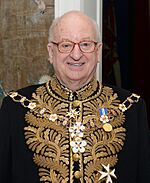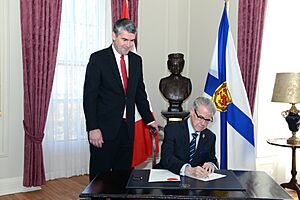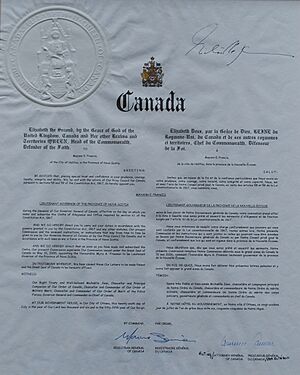Lieutenant Governor of Nova Scotia facts for kids
Quick facts for kids Lieutenant Governor of Nova Scotia |
|
|---|---|

Flag of the lieutenant governor of Nova Scotia
|
|

Emblem of the lieutenant governor
|
|
| Viceroy | |
| Style | His Honour the Honourable |
| Residence | Government House, Halifax |
| Appointer | The governor general on the advice of the prime minister |
| Term length | At the governor general's pleasure |
| Formation | 1 July 1867 |
| First holder | Sir Charles Hastings Doyle |
The lieutenant governor of Nova Scotia is a very important person in the province of Nova Scotia. They are the official representative of the King of Canada in Nova Scotia. This means they act on behalf of the King, who is also the head of state for Canada and other Commonwealth realms.
The lieutenant governor of Nova Scotia is chosen in the same way as other provincial representatives across Canada. Their main job is to carry out most of the King's duties for the province. The current, and 33rd, lieutenant governor of Nova Scotia is Arthur Joseph LeBlanc. He has been in this role since June 28, 2017.
Contents
What Does the Lieutenant Governor Do?
The lieutenant governor of Nova Scotia has many important jobs. These include both official government duties and special public appearances.
Government Duties
The lieutenant governor plays a key role in how the government of Nova Scotia works. For example, they formally approve new laws passed by the provincial government. They also officially open and close sessions of the provincial legislature. This ensures that the government follows the rules and traditions of Canada's system.
Ceremonial Roles and Community Involvement
The lieutenant governor also takes part in many special events and ceremonies. They often act as a patron or honorary member for different groups in Nova Scotia. These include organizations like the Multicultural Association of Nova Scotia and the Nova Scotia Salmon Association.
They also present special awards to deserving people in Nova Scotia. One important award is the Order of Nova Scotia. When a new lieutenant governor starts their job, they automatically become a Knight or Dame of Justice in the Venerable Order of Saint John. This order is known for its work in health and humanitarian aid. The lieutenant governor presents many other provincial honours and awards throughout the year. These awards often celebrate people who have done great things for their community.
The lieutenant governor attends hundreds of events each year. They might host events or be the guest of honour. For example, in 2006, the lieutenant governor attended 289 events, and in 2007, they attended 384!
Symbols of the Office
When the lieutenant governor is at an event, you might see their special flag. This flag has a blue background with the Arms of Nova Scotia in the middle. Above the arms is a crown, and around it are ten gold maple leaves. These leaves stand for Canada's ten provinces. Before 2024, the flag looked different. It had the Union Jack (the flag of the United Kingdom) with the Nova Scotia arms.
In Nova Scotia, the lieutenant governor is a very important person. They are second only to the King himself in the province's official ranking. This means they rank higher than other members of the Canadian Royal Family and even the King's federal representative.
The lieutenant governor also has special helpers called aides-de-camp. These helpers wear uniforms with a special badge. The badge shows the lieutenant governor's flag in the shape of a shield, topped with a crown. This badge was designed by the Canadian Heraldic Authority and approved in 2011.
History of the Office
The role of lieutenant governor in Nova Scotia has a long history. It officially began in 1786. At that time, the British government decided that Nova Scotia, along with other colonies like New Brunswick and Quebec, should each have a single governor. The person in charge of all these governors was called the "governor-in-chief." The lieutenant governor was their representative in each colony.
The modern version of the office started in 1867. This was when Nova Scotia joined Confederation and became part of Canada. Since then, 30 people have served as lieutenant governor of Nova Scotia.
Some of these lieutenant governors were very important "firsts":
- Myra Freeman was the first woman to hold the job.
- Mayann Francis was the first lieutenant governor of Black Nova Scotian background.
The shortest time someone served as lieutenant governor was Joseph Howe, who held the position for only three weeks in July 1873. The longest serving lieutenant governor was Malachy Bowes Daly, who served for ten years, from 1890 to 1900.
See also
- Monarchy in the Canadian provinces
- Government of Nova Scotia
- Lieutenant Governors of Canada






